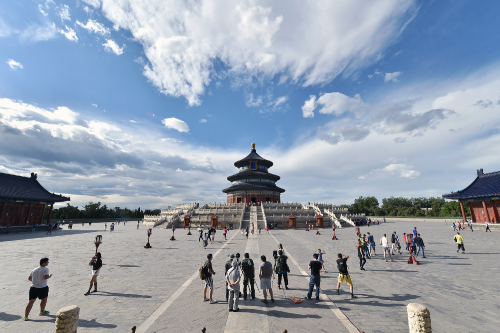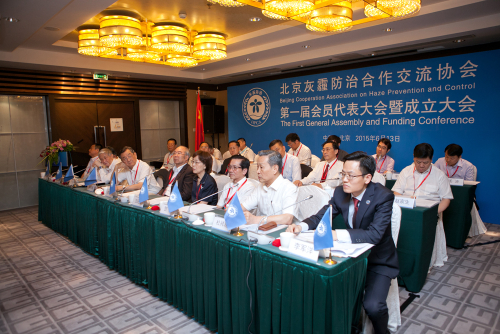 |
|
The Temple of Heaven in Beijing under the blue sky and white clouds on June 12 (XINHUA) |
For four days in a row, beginning on June 11, Beijing saw a glittering blue sky with jade-white clouds floating above, a rare treat for a city usually covered in gray smog.
"Today is like a holiday, and almost everybody has walked out to watch the sky," said Hao Li, a 30-year-old Beijing citizen, on June 12. "Many of my friends said they would do nothing but stare at the sky today. I don't remember how long it's been since I've seen the sky like this."
People jokingly call this symptom "blue sky syndrome," in which people get very excited at seeing the blue sky. People took pictures of the sky and shared them online.
On June 13, underneath another dazzling blue day, the Beijing Cooperation Association on Haze Prevention and Control was set up in the capital. It is China's first association aiming to working out a solution to haze.
"If Beijing's sky can be like today all the time, there is no need to set up such an association at all, but unfortunately, pollution might still persist for a long time," said Du Xiangwan, former Vice President of the Chinese Academy of Engineering (CAE), at the association's conference.
The cause of "blue sky syndrome" is that blue sky has become a luxury in Beijing, according to Hou Chunyun, former Deputy Director of the Development Research Center of the State Council. "So people get excited at seeing this. In the past two days, when we looked up, we saw lovely blue sky, and when we looked down, we saw pictures of blue sky that friends took and shared in social media. It is actually a sad reflection," said Hou.
The truth is that Beijing's haze has become a defining aspect for the city worldwide.
"No matter where we go, as long as people know we are from Beijing, the first thing they bring up is the haze. They would express their sympathy to us. Haze has already become a defining characteristic for Beijing," said He Keng, former Deputy Director of the Jiu San Society, one of China's eight non-Communist political parties.
Further, it's not just Beijing--another city Tianjin, as well as the whole Hebei Province are all victims of the heavy smog.
Origin of haze
Although many experts have given data claiming to know the cause of China's pollution, there is still no fixed answer for the question.
"One of the main tasks for the association is to find the real cause of the haze," said He. "Some say it is the result of coal burning, and others blame it on vehicle emission and chemical plants. But in the 1950s and 1960s, Beijing burnt more coal, and there were more heavy chemical plants in the city, but the pollution was not this bad."
He is personally of the opinion that vehicle emissions are the main cause of the pollution, but he reminds people that the blame game is an unproductive one.
"We need to figure out an accurate answer," He said. "We can't take suppositions for granted."
Hao Jiming, newly elected Director of the Beijing Cooperation Association on Haze Prevention and Control and a member of the CAE, reported at the conference about a project the Chinese Academy of Engineering completed on preventing and controlling PM 2.5 airborne particles in China. According to the report, the cause of haze is a combination of many factors: industrial discharge, vehicle emission, residential coal burning, and pollutants emitted from farmland--mainly ammonia--but the proportion of each factor varies in different time and different regions.
Hou, on the other hand, expressed his concern on the balance of economic development and environmental protection at the conference.
"If the main cause of the pollution is focusing only on economic development and ignoring the environmental protection, we may face another problem--would the heavy emphasis on the environmental protection slow down our economic development?" said Hou.
Chen Wenling, chief economist from the China Center for International Economic Exchanges, expressed her idea on this issue. "In the past 33 years, China's GDP has increased at an average speed of 9.6 percent. This increase is at the price of overexploration of natural energy and ecological resources. Now we are at the phase of adjusting the economic structure," said Chen.
"The fight against haze is a very complicated battle with many factors involved," said Hou. "The foundation of the association is the start of building up a whole system to deal with this crucial problem."
 |
|
The Beijing Cooperation Association on Haze Prevention and Control is set up and holds its first conference on June 13 (BY COURTESY OF THE ASSOCIATION) |
Green economy
For some smart companies, balancing economic benefits and clean energy is not a conflict.
China Inner Mu Biomass Power Co., a private company based in the Inner Mongolia Autonomous Region, for example, has explored a new economic path that integrates desert control with biomass thermoelectricity and blue-green algae production in China.
The company seeks sandy land with aquifers to plant desert willow, a type of shrub that can easily survive and grow in a desert due to its well-developed root system. The plant is widely known as "green coal" for power plants because, when burned, it not only releases more thermo capacity but also has much cleaner emissions than traditional coal.
"One magic thing about desert willow is that it has to be cut down every three to five years in order to survive, or it will die in its sixth or seventh year," said Chen Yuchuan, General Manager of the company. "Once the sand is stabilized, grass and other kinds of bushes will naturally grow out. So within years, the sand will be capped with green plants."
This new burning way has brought carbon emissions down by 250,000 tons annually. The International Energy Conservation and Environmental Protection Association (IEEPA), a non-governmental organization dedicated to energy conservation and sustainable development in China, has been a big player in pushing forward the company's low-carbon drive while teaming up with the UN Industrial Development Organization.
"The model is unique and viable in desert control. More importantly, it can improve the well-being of local people and spur the local economy," said Jiang Minglin, an official with the State Council, when visiting the Mu Us Desert and the company, a field trip initiated by IEEPA.
Copyedited by Kylee McIntyre
Comments to yuanyuan@bjreview.com
